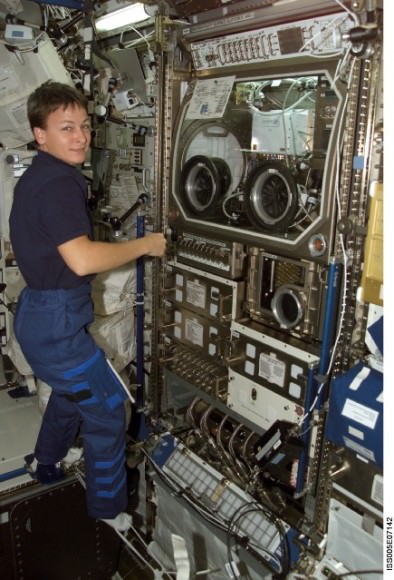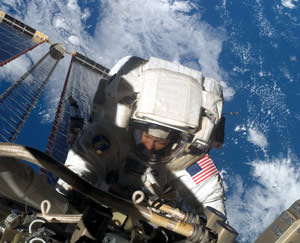[/caption]
This post is part of Ada Lovelace Day, which is a worldwide effort to get as many people as possible to blog about a heroine of science or technology. Ada was a mathematician who lived in the 1800’s who created the first computer program. Yep — you read correctly — a computer in the 1800’s. It was actually a device called an analytical engine, which was an important step in the history of computers. You can read more about Ada and Ada Lovelace Day here.
The person I chose to write about is a goddess of both science AND technology. She is a biochemist and an astronaut. She was the first science officer on board the International Space Station and later become the first female commander of the ISS. She helped get some of the initial science programs going on the on the space station, and as commander oversaw a period of one of the biggest expansions for the station, coordinating the additions of European and Japanese laboratory modules. Her name is ….
Dr. Peggy Whitson
Perhaps I have always been drawn to Whitson because she grew up in a rural, agricultural environment, as I did. But I have always found Whitson to be endearing because of her easygoing and friendly personality. But yet, she must be almost a “slave-driver” and perfectionist when it comes to her work. During her expeditions on the ISS, Whitson earned a reputation for high achievement, which prompted mission planners to assign the crew extra work every day. NASA called it “The Peggy Factor.”
“We account for the fact that Peggy is going to do things more efficiently, and that she likes to work some on her time off, and so she’ll accomplish more,” said NASA deputy station project manager Kirk Shireman.

First some the details about Whitson: she graduated from Iowa Wesleyan College in 1981, and received her doctorate in biochemistry from Rice University in 1985. She worked as a Welch Postdoctoral Fellow before joining NASA in 1986.
From 1989 to 1993, Whitson was a research biochemist for NASA. During that time, she also served as an Adjunct Assistant Professor at the University of Texas and Rice University. In 1995, she became co-chair of a combined American and Russian working group, and a year later she was named an astronaut candidate.
Whitson flew her first space mission in 2002 as a flight engineer to the International Space Station as part of the Expedition 5 crew. While there, then NASA Administrator Sean O’Keefe gave her the title of first NASA Science Officer. Of course, she took some ribbing about being like “Spock,” the science officer on the original Star Trek, but she came to enjoy using the phrase “Live Long and Prosper.” During that mission she performed 21 experiments in human life science, microgravity sciences and commercial payloads.
During her second stint on the station, Expedition-16 in 2007-2008, she was named the commander.
I could go on about her accomplishments, but perhaps even better would be to let Whitson herself tell about her experiences in space. During her stays on the ISS, she wrote “letters home” to family and friends, answering questions and sharing details of her days in space.
Here’s what she had to say about doing science on the ISS:
I set up the first experiment inside the microgravity sciences glovebox this week. Tomorrow, I will do the powered checkouts of the glovebox and the next day start up the experiment. It is ssssoooo cool, getting to do science in space!!! This week we are also doing the urine collections for the renal stone investigation…and while I suspect this won’t be especially fun to collect the samples, I do think it’s one of the best experiments (I am biased, of course, since it is my experiment!).
In reading her letters, I found it interesting that she did amateur astronomy while on board the space station!:
One evening, I had dimmed the lights inside the module so that I could better watch the Earth/stars. I watched the sun set as we moved into the shadow of the Earth. I was pleasantly surprised a few min later to see a half-moon rise into view from behind the Earth. As the stars started popping into view, I was surprised again, as I saw a satellite pass by above us, looking so much like one of the other stars, but moving across the field of “constant” stars. I had never thought about the fact that I could, as one of those satellites, actually see another! And then I saw a second! Amazing.

Whitson has conducted six spacewalks. Here’s how she described her first one:
My first look, as I poked my head out the hatch, was amazing! I previously compared the view of being in space to having lived in semidarkness for several years and having someone turn on the lights. Well, the view from my helmet, continuing the same analogy, would be like going outside on a sunny, clear day after having lived in semidarkness for years! If it gets better than this, I’m not sure my mind would be able to comprehend it!
And in this letter home, she waxes poetically about seeing Earth from space. She also talks about how people on Earth can watch for the ISS in the night sky, which is something that I love to do, and so it was interesting to read her perspective on that as well:
Although all the views of our planet are incredible and varied from our viewpoint up here on the Station, with the colors, textures, and lighting changing as we orbit…the most impressive view is the curve of the planet at the horizon. That curve is the special place where it is possible to see the layers of atmosphere extend beyond the surface to meet with the blackness of space beyond. Relative to the size of the Earth, it seems impossibly thin, less than a finger-width. The atmosphere carries all the shades of blue in that thin band, closest to the planet a glowing blue, like sunlit water over white sand, extending to the deepest blue-purple mixture that holds the blackness at bay.
As the night-side of the planet slips by beneath me, it carries on the fringes of darkness the colors of a sunset on the clouds below. The Station is still lit by the sun, despite the fact that we have already crossed the terminator between day and night below us. This is the timeframe when Station is most visible to folks on the ground, just before their dawn or after their dusk. A small bit of sunlight reflected off of our structure, illuminates us moving across their darkened sky. As the terminator approaches the horizon, the sun shows a blinding face that burns the atmosphere with molten reds and oranges before seemingly melting itself into the darkness, leaving a royal blue line that dissipates more slowly as the stars come out from hiding. Less than an hour passes before our path around the planet brings us back to the royal blue curve, signaling sunrise, as the process reverses itself. I am sure that after I return, I will again miss watching the curve of the Earth.
You can read more of Whitson’s letters home here.
Whitson’s ride home from space after Expedition 16 was more dramatic than expected. A malfunction made the Soyuz enter Earth’s atmosphere at a steeper angle than normal and the crew experienced “ballistic” descent at eight times the force of Earth-normal gravity. But, thankfully, everything turned out OK.
Whitson is currently chief of NASA’s astronaut office at Johnson Space Center.
Sources: Official NASA Astronaut bio, Orlando Sentinel

